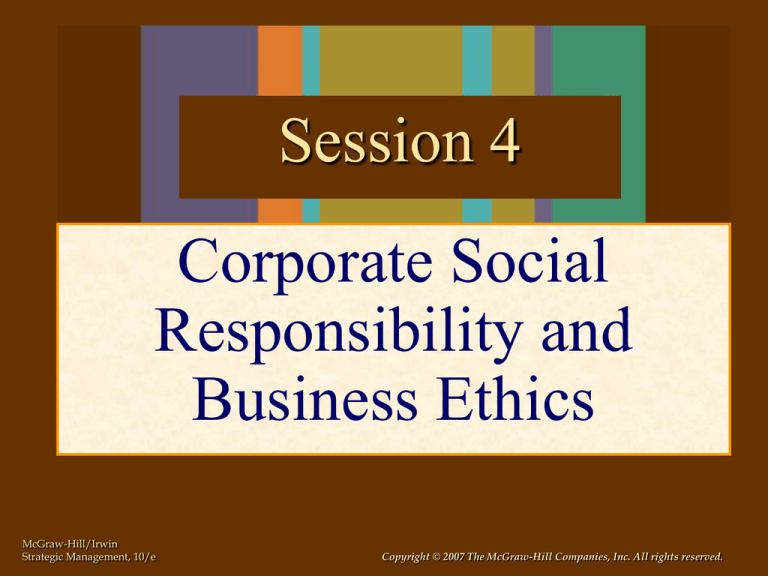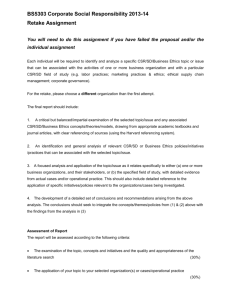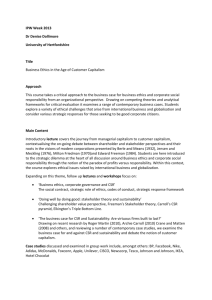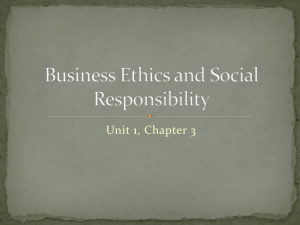
Session 4
Corporate Social
Responsibility and
Business Ethics
McGraw-Hill/Irwin
Strategic Management, 10/e
Copyright © 2007 The McGraw-Hill Companies, Inc. All rights reserved.
3-2
Learning Objectives
1.
2.
3.
4.
5.
6.
7.
Understand importance of stakeholder approach
Explain the continuum of social responsibility
Describe a social audit
Discuss the effect of Sarbanes-Oxley, 2002
Compare advantages of collaborative social initiatives
Explain the 5 principles of collaborate social initiatives
Compare the merits of different approaches to business
ethics
8. Explain relevance of business management practice
9. Ethics to strategic
3-3
Word of the Day
STAKEHOLDER
3-4
Stakeholder Approach
According to Stakeholder Approach:
• In defining or redefining the company mission,
strategic managers must recognize the legitimate
rights of the firm’s claimants.
• These include outside stakeholders affected by the
firm’s actions.
3-5
Perceived Stakeholders
•
•
•
•
•
Customers
Government
Stockholders
Employees
Society
3-6
Steps to Incorporate Stakeholders:
1. Identification of stakeholders
2. Understanding stakeholders’
specific claims vis-à-vis the firm
3. Reconciliation of these claims
and assignment of priorities
4. Coordination of the claims with
other elements of the company
mission
3-7
Dynamics of Social Responsibility
•
•
•
•
Inside vs. Outside Stakeholders
Duty to serve society plus duty to
serve stockholders
Flexibility is key
Firms differ along:
–
–
–
–
–
Competitive Position
Industry
Country
Environmental Pressures
Ecological Pressures
Inputs to the Development of
Company Mission
3-8
3-9
Types of Social Responsibility
•
•
•
•
Economic – the duty of managers, as agents of the
company owners, to maximize stockholder wealth
Legal – the firm’s obligations to comply with the
laws that regulate business activities
Ethical – the company’s notion of right and proper
business behavior.
Discretionary – voluntarily
assumed by a business
organization.
3-10
CSR & Profitability
•
Corporate social responsibility
(CSR), is the idea that business has a
duty to serve society in general as well
as the financial interests of
stockholders.
•
The dynamic between CSR and
success (profit) is complex. They are
not mutually exclusive, and they are
not prerequisites of each other.
Factors Complicating a
Cost-Benefit Analysis of CSR:
3-11
1. Some CSR activities incur no dollar costs at all. In
fact, the benefits from philanthropy can be huge.
2. Socially responsible behavior does not come at a
prohibitive cost.
3. Socially responsible practices may create savings,
and, as a result, increase profits.
4. Proponents argues that CSR costs are more than
offset in the long run by an improved company
image and increased community goodwill.
3-12
CSR Today
•
•
•
•
Priority of American businesses
Resurgence of Environmentalism
Increasing Buying Power among Consumers
Globalization of Business
3-13
Sarbanes-Oxley Act of 2002
•
•
•
•
•
•
•
CEO and CFO must certify every report
containing company’s financial statements
Restricted corporate control of executives,
accounting firms, auditing committees, and
attorneys
Specifies duties of registered public
accounting firms that conduct audits
Composition of the audit committee and
specific responsibilities
Rules for attorney conduct
Disclosure periods are stipulated
Stricter penalties for violations
3-14
New Corporate Governance Structure
•
•
•
•
Restructuring governance structure in American
corporations
Heightened role of corporate internal auditors
Auditors now routinely deal directly with top
corporate officials
CEO information provided directly by the
company’s chief compliance and chief
accounting officers
The New Corporate Governance
Structure
3-15
3-16
CSR’s Effect on Mission Statement
• The mission statement embodies what
company believes
• Managers must identify all stakeholder
groups and weigh their relative rights and
abilities to affect the firm’s success
3-17
Social Audit
• A social audit is an attempt to measure a
company’s actual social performance against
its social objectives.
• The social audit may be used for more than
simply monitoring and evaluating firm social
performance.
3-18
Management Ethics
The Nature of Ethics in Business:
• Belief that managers will behave in an ethical
manner is central to CSR
• Ethics – the moral principles that reflect society’s
beliefs about the actions of an individual or a
group that are right and wrong
• Ethical standards reflect the end product of a
process of defining and clarifying the nature and
content of human interaction
3-19
Approaches to Questions of Ethics
• Utilitarian Approach
• Moral Rights Approach
• Social Justice Approach
–
–
–
–
–
Liberty Principle
Difference Principle
Distributive-Justice Principle
Fairness Principle
Natural-Duty Principle
3-20
Code of Business Ethics
•
•
To help ensure consistence in the application of
ethical standards, an increasing number of
professional associations and businesses are
establishing codes of ethical conduct.
The following all have ethics codes:
–
–
–
–
–
–
Chemists
Funeral directors
Law Enforcement Agents
Hockey Players
Librarians
Physicians
3-21
Major Trends in Codes of Ethics
1. Increased interest in codifying business ethics has
led to both the proliferation of formal statements
by companies and to their prominence among
business documents.
2. Such codes used to be found solely in employee
handbooks.
3. Companies are adding enforcement measures to
their codes.
4. Increased attention by companies in improving
employees’ training in understanding their
obligations under the company’s code of ethics.








